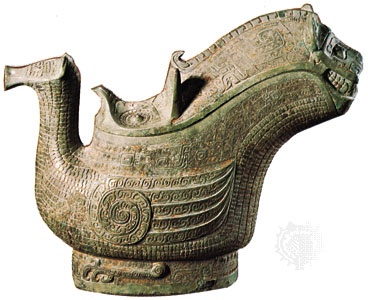gong
bronze work
Wade-Giles romanization kung
 type of Chinese bronze vessel used to serve wine, it was characterized by an unusually fine harmony between shape and decoration. It was produced during the Shang (c. 1600–1046 BC) and early Zhou (1046–256 BC) dynasties.
type of Chinese bronze vessel used to serve wine, it was characterized by an unusually fine harmony between shape and decoration. It was produced during the Shang (c. 1600–1046 BC) and early Zhou (1046–256 BC) dynasties.The gong looked much like a sauce server, with a large spout extending from one end of the oval-section body and a vertical handle at the other end. All vessels classified as gong had a lid covering the entire top of the vessel, including the spout. The spout end of the lid typically had a bovine or feline head, and the opposite end had an owl or birdlike mask. These elements harmonized with the decoration of the body, which sometimes created the illusion of delineating the rest of the animal or provided complementary, zoomorphic motifs—such as the monster mask, or taotie—characteristic of the bronze art of the Shang and early Zhou.
musical instrument
 a circular metal plate-like percussion instrument, usually having a turned-down rim. In most forms it is struck in the centre with a felt- or leather-covered beater, producing a sound of either definite or indefinite pitch. Its vibrations issue from the centre, in contrast to bells (bell), which vibrate principally at the rim. Gongs may have shallow or deep rims (kettle gongs (kettle gong)) and may be bossed (knobbed in the centre) or unbossed. Rimless gongs occur occasionally.
a circular metal plate-like percussion instrument, usually having a turned-down rim. In most forms it is struck in the centre with a felt- or leather-covered beater, producing a sound of either definite or indefinite pitch. Its vibrations issue from the centre, in contrast to bells (bell), which vibrate principally at the rim. Gongs may have shallow or deep rims (kettle gongs (kettle gong)) and may be bossed (knobbed in the centre) or unbossed. Rimless gongs occur occasionally.Gongs are pictured in China in the 6th century AD and were used in Java by the 9th century. (The word gong is Javanese.) A deep-rimmed Roman gong from the 1st or 2nd century AD was excavated in Wiltshire, Eng. Flat gongs are found throughout South and East Asia, and knobbed gongs dominate in Southeast Asia. Flat gongs (gangsa) used in ensembles of the northern mountains of the Philippines are struck by hand, like drums, and create resultant melodies through the use of various rhythmic patterns. The kulintang ensembles of the southern Philippines use a rack of tuned, knobbed gongs, but the musicians define pieces through rhythmic patterns rather than specific melodies. The bossed gong chimes of Southeast Asian ensembles may either play melodies or function as time markers, i.e., they define large rhythmic units. In East and Southeast Asian religions, knobbed gongs are used to mark sections of chant or ceremony. Large bossed gong ensembles such as the saing-waing of Myanmar (Burma), pi phat of Thailand, and gamelan of Indonesia continue a rich tradition of concert, theatre, and ceremonial music.
The Western orchestra uses the flat Chinese gong of indefinite pitch (called tam-tam in the West); beginning in the late 20th century, some composers called for such gongs to be played by passing a violin bow along the edge. Occasionally, orchestral music calls for the use of deep-rimmed gong chimes. Acoustically, steel drums (steel drum) of the type originated in Trinidad are multiple-toned gongs.
- Henry Charles Keith Petty-Fitzmaurice Lansdowne, 5th marquess of
- Henry Chettle
- Henry Christophe
- Henry Clay
- Henry Clay Folger
- Henry Clay Frick
- Henry Clifton Sorby
- Henry Compton
- Henry Condell
- Henry Cooke
- Henry Cort
- Henry Cowell
- Henry Crabb Robinson
- Henry Cromwell
- Henry Crown
- Henry Cuyler Bunner
- Henry Darwin Rogers
- Henry David Thoreau
- Henry Dearborn
- Henry de Bracton
- Henry Demarest Lloyd
- Henry de Montherlant
- Henry Deringer
- Henry Draper
- Henry Draper Catalogue